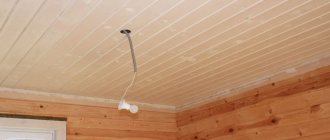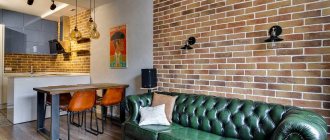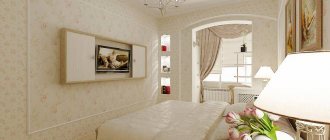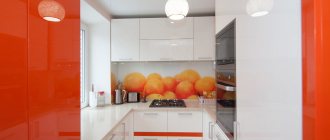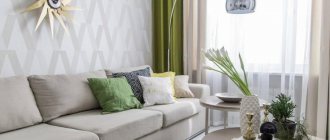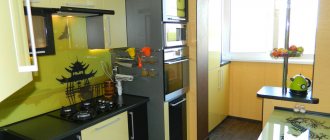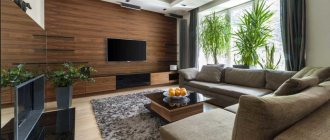In apartments and private houses, designers often use zoning. The living room and kitchen combine well. Two rooms connected to each other look spacious, and this layout will make the space cozy. You can update the design, implement interesting ideas, or repeat a design seen in a magazine, TV show, or photo on the Internet. The style in the living room-kitchen can be different, and choosing it can turn into an exciting experience. Before combining rooms, designers advise taking into account the basic rules, creating a project, choosing colors.
Zoning
Designers do not advise giving in to fashion trends and copying design ideas without taking into account dimensions, location and other nuances. Before planning and arranging furniture, every detail is thought through. There are several simple rules that experts advise you to follow:
- Let the room have natural light. To do this, remove excess walls (except for load-bearing ones).
- If the rooms in the apartment are small (12 sq. m or 16 sq. m), the layout of the kitchen combined with the dining room will be the right solution.
- If the ventilation system is not designed correctly, the smell of food will spread throughout the apartment.
Partitions
The interior of the kitchen and living room begins to be thought out from the junction of two zones. Here are some of the methods and objects that delimit the space: installing a bar counter; a kitchen island; a large table; installing a low partition. Designers advise installing a wide counter, since you can sit at it like at a regular table, and high chairs are quite suitable for the whole family. However, in small rooms (16 sq m), narrow counters are installed. Kitchen islands are convenient to use, but are only suitable for large kitchen-dining rooms (25 sq m or 30 sq m). Capital low partitions are installed only if it has been decided in advance what they will be used for (for example, as a TV stand).
Furniture items
A few examples of furnishing a kitchen combined with a living room:
- 1. Sofa. It becomes an object that zones space. The sofa is placed with its back facing the place where food is prepared. In small rooms (less than 20 sq m) a corner is placed, which is placed against a wall installed perpendicular or parallel to the kitchen.
- 2. Set. According to designers, minimalist models without elaborate details look modern. The service, vases or glasses are placed on an open shelf. You can buy a fashionable display case for them. Furniture is placed near the wall. If the space is large (20 sq. m, 25 sq. m or 30 sq. m), then in the central part you can install an island, which also has sections for kitchen appliances.
- 3. Furniture set. The style should be combined with the design of both rooms. In small rooms, a compact table and chairs made of transparent material or painted in light colors look good. You can add a table with a round top to your living room interior. In spacious rooms, the kit is installed near the wall or in the central part. An elongated rectangular dining table would look good here.
Read here: Combined living rooms - stylish ideas and the best style combinations for combined living rooms (105 photos)
Whitewashed ceilings
Simple whitewash is gradually fading into oblivion, but is still used in interior decoration. This is a good and economical option for ceiling decoration, especially in situations where, due to the small height of the ceilings, it is impossible to use suspended and tension structures. In addition, not everyone can afford to spend money on fairly expensive ceiling systems. Therefore, ordinary whitewashing remains relevant.
For such a simple way to decorate the ceiling in the kitchen-living room, you don’t need specific skills and tools, just whitewash and a roller are enough. But, despite the efficiency and emptiness, this method has two disadvantages:
- short service life;
- you will have to forget about sophistication and beauty.
Multi-level floor
To zone the space, craftsmen install floors at different levels. They advise installing a podium to separate the kitchen and dining room. This option is considered one of the most practical because, among other things, the owners have additional free space where they can hide something. It is convenient to use boxes or drawers for this. Wicker baskets will look good. But such space can remain free.
For podiums, reliable materials are selected that can withstand heavy loads. Usually builders make wooden or metal podiums.
However, such a design should not be made if there are small children in the family, since the podium can become an obstacle for him. In addition, various floor coverings can be used. They will zone the space between the living room and the kitchen and protect the podium from damage. For example, tiles are laid in the kitchen area, and laminate flooring in the dining room. The main thing is to choose colors and textures and combine the finishes correctly.
Ceiling structures made of plasterboard
GKL is an excellent material for ceiling finishing in kitchens combined with a living room, since its capabilities allow you to realize many ideas for zoning space. Drywall is a very durable and quite flexible material, which allows you to give ceilings a wide variety of shapes.
You can make a partition from gypsum plasterboard, separating the work area and the living room. If you also choose the right lighting, the room will dramatically change for the better. The living room and kitchen, already separated by a ceiling partition, are decorated according to identical rules. For example, the work area can be further highlighted and highlighted with the help of well-installed borders. You can visually expand a small living room with the help of light directed from the walls to the ceiling.
Loft
This year the style remains in demand. It is often used to equip kitchens combined with a living room. This combination gives more free space, which will only emphasize all the details of the loft.
Today, such a definition as “classic style” is used less and less by designers. Loft - any interior design in which various technical elements are not hidden, but emphasized.
For example, stylists play with brickwork, wires or concrete walls. The photographs clearly show how successful it can look like a living room that is combined with a kitchen. For loft, rough and heterogeneous surfaces and rough materials are selected. In apartments decorated in this style, wall lamps are installed. In this case, the light is directed along the walls. Due to this, shadows fall so that uneven surfaces look three-dimensional. At first, loft was viewed with caution, but it quickly became popular. Designers do not hide finishing materials and even fake them. To imitate a concrete surface and smudges, decorative plaster is used.
Illuminated ceiling in the living room
As you know, light in the living room plays a very important role. A suspended ceiling is a convenient solution that can be used in most homes. The most popular among them are structures that can be made of plasterboard, as well as metal, wood, wood or plastic panels. Stretch ceilings made from special flexible films are very popular.
Thanks to a suspended or suspended ceiling in the living room, you can get an extraordinary character of interior lighting, especially if the surface is made in several planes and combined with effective spotlights. Using suspended ceilings made of plasterboard or fiber-plasterboard, you can also form slopes, arches and arcades.
Modern ceiling designs are so diverse that you can choose the most suitable option for your home or apartment.
Provence
The name of this destination comes from a region in the south of France. Even a small kitchen-living room, the decor of which was inspired by French aesthetics, will be filled with warmth and comfort.
The main thing is that it has a lot of daylight, textiles with romantic prints, and floral patterns. The dining room in the Provence style is designed in pastel shades. Furniture items can be vintage or artificially aged. Plain walls will contrast with large checkered curtains. The door in the kitchen area set is sometimes replaced with curtains made from the same material as the tablecloth. A good addition would be vases and figurines, clay pots, forged metal parts and ribbons.
Plasterboard structures
Combining a living room and kitchen with high ceilings, most designers install multi-level plasterboard structures. From a design point of view, this solution is universal, although it requires quite a lot of time to implement: for this option you need to build a complex frame and finish it with plasterboard sheets.
This method is not used to create a single, even ceiling. But zoning of varying degrees is performed masterfully.
- Two-level - in the simplest case, a figure of the second level is formed above the kitchen area, and a figure of the first level is formed above the living room, since it has a large area. A more complex option involves creating several second-level figures, for example, a wide rectangular beam with built-in lamps that separates the kitchen from the living room, and second-level figures around the perimeter of each zone.
In the techno style, a combination of geometrically correct second-level figures or niches with the same clear outlines simultaneously emphasizes a single space and structures it to the proper extent. In this way, you can create smaller zones - above an armchair and a work table, for example, above a bar counter.
The configuration is possible and as curvilinear as desired: plasterboard is flexible and allows you to create the most complex shapes. This option is more suitable for various classical styles, as well as high-tech and fusion styles.
- If the height of the room allows, multi-level ceilings are installed - with three or even more height differences. This design can be extremely decorative and complex. It is the ability to form any volume with any configuration from plasterboard that makes it a favorite material for designers.
In addition, drywall can be painted, whitewashed, wallpapered, tiled, and even hand-painted.
Color combinations
Stylists advise taking into account the following nuances:
- direction in the interior;
- combination of shades;
- illumination
It is much easier to choose a palette if the style for the kitchen and living room has already been selected. For example, neoclassicism and Provence have their own combinations. In a classic interior, designers combine pastel colors, pale colors, which are slightly diluted with dark shades. In French country houses you can often see soft blue, pink, and pistachio colors. Art Deco designers make up objects and finishing materials in black and white, sometimes beige and brown or silver and black. The main thing is to choose a shade for the walls. White will become universal, it will expand the space, and later you can paint them with any paint. However, in the cooking area, white ceases to look fresh. Beige or gray shades would be more practical. This background will highlight the other colors. In a monochrome interior, designers recommend gluing wallpaper in an unusual color or with a photo print.
Waterproof surfaces are easy to clean, so washable wallpaper is recommended. The colors of the furniture echo the details and accessories, be it cushions for the sofa, curtains or other items.

